ISP Explainer No. 09
This ISP Explainer No. 9 is published on January 5, 2023, as a translation of the original Burmese language version that ISP-Myanmar sent out to the ISP Gabyin members on December 27, 2023.
As the Three Brotherhood Alliance’s (3BHA) ‘Operation 1027’ gains momentum, China has begun to intervene. China has facilitated dialogue between the conflict parties by hosting two meetings in Kunming between the 3BHA and the State Administration Council (SAC), however no satisfactory resolutions have yet been reached. Concurrently, the Chinese government issued arrest warrants for former Kokang leader Bai Suoqian and nine other members of the Bai, Wei, Liu, and Ming families. This underscores China’s apparent intention to remove the current leadership in Kokang. In terms of bilateral investments, there is a sense of urgency to implement plans such as the Kyaukphyu Special Economic Zone. Meanwhile, the Lancang-Mekong Cooperation Summit was resumed after being halted for almost three years. The junta’s leader was allowed to attend it, marking the first regional summit-level meetings allowing him to attend.
Summary of 130 China-Myanmar Relations Issues
An analysis of ISP-Myanmar’s timeline on China-Myanmar relations in October and November 2023 reveals a total of 130 issues documented (See table below), with the dominant subjects being political economy, transnational crime, and geopolitics. In this Explainer No. 9, ISP-Myanmar will showcase a concise overview of five pivotal issues in these subjects, by linking them with significant developments in December.
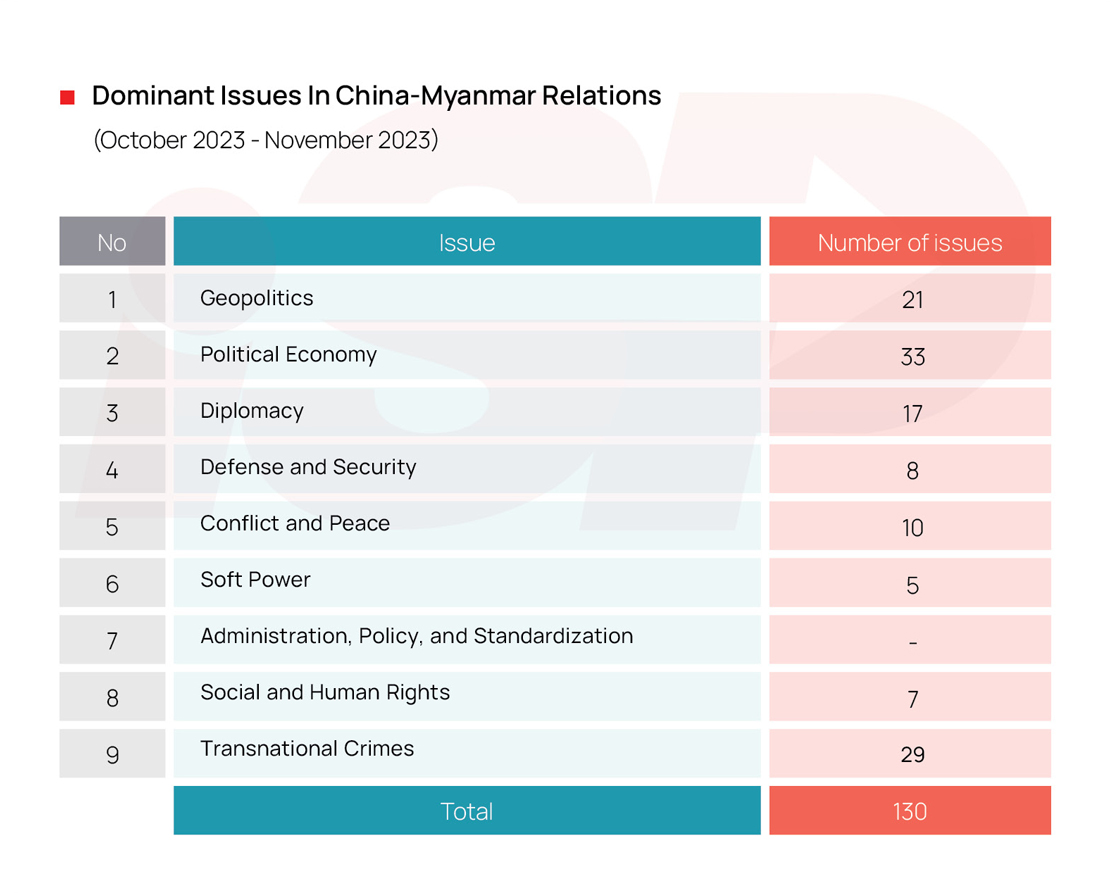
1. Misfortune for Kokang’s Bai Family
The Chinese government issued an arrest warrant for the former Kokang leader and Chinese national identification card holder Bai Suoqian, along with nine others, on December 10. The arrest warrant identified influential figures in the Kokang region, including Bai Suoqian, the leader of the Bai family, Col. Wei San (Wei Huairen) of the Wei family, and Liu Zhengxian of the Liu family. This signifies the measures aimed at dismantling the authority and power granted directly or indirectly by the Myanmar military to the ruling families in the Kokang region since 2009. Prior to this incident, the Ming family, one of the four major powerful families in Kokang, had already faced warrants issued by China. On November 16, the SAC arrested Ming Xuechang, along with four family members, and transferred them to Chinese police. However, the SAC announced that Ming Xuechang committed suicide by shooting himself during the arrest.
The SAC might be facing a major crisis this time, especially considering that Bai Suoqian is at the top of China’s warrant list. Bai played a crucial role in assisting Peng Jiasheng in removing Yang Maoliang from the MNDAA in 1992. However, during the 2009 Kokang Incident, Bai sided with the Myanmar military to oust Peng Jiasheng. Bai subsequently expanded his influence within Kokang and gained recognition within the Myanmar military by becoming a member of the Amyotha Hluttaw (the upper house of parliament). The head of the Wei Family, Wei Huairen (Col. Wei San), serves as the chairman of the supervisory committee of the Border Guard Force 1006 (Kokang Self-Administered Zone), in addition to being a representative of the Pyithu Hluttaw (the lower house of parliament). Liu Zhengxiang, from the powerful Liu family, is also a prominent political member of the Kokang Self-Administered Zone. In essence, the ten individuals currently under arrest warrants oversee Kokang’s military, administration, and business sectors and are all also disciples of the former leader Bai Suoqian. Now, though, is a fateful time of reckoning for the Bai family and their associates.
In November, following the Chinese government issuing arrest warrants for the Ming family, the SAC subsequently arrested them. However, the SAC spokes-person dismissed reports of Bai Suoqian’s son, Bai Yingcang, being subject to an arrest warrant as false. It will be interesting to see how the SAC handles the current situation. As per ISP OnPoint No. 17, the most recent warrant list reveals China’s intention to reconfigure power in northern Shan State, specifically by tackling online crime and cybercrime through “substituting Bai Suoqian and current leadership in Kokang.”
It is noteworthy that preceding the issuance of warrants for Bai Suoqian and nine others between December 7 and 9, China mediated a dialogue meeting between the SAC’s delegates and representatives from the 3BHA at the Kunming Haigeng Hotel. China claimed that a temporary ceasefire was agreed upon as a result of this meeting. The SAC then announced that further discussions with the 3BHA would take place by the end of December in order to seek political solutions, with China’s assistance. Despite the second meeting being held from December 22 to 24 in Kunming, China, resolutions satisfactory to both parties were not reached.
The crackdown by the Beijing government on Kyar Phyant (诈 骗) online gambling and the repercussions of the 3BHA’s ‘Operation 1027’ have directly impacted individuals previously favored by the Myanmar military in Kokang. At present, Laukkai remains the sole target yet to be captured by the MNDAA as part of the objectives of ‘Operation 1027.’ Whether Laukkai will eventually be taken through military action or whether political negotiations will succeed in averting urban warfare and the associated destruction depends on the plans of Peng Jiasheng’s son, Peng Deren, who currently leads the MNDAA, the response of the junta, as well as the ongoing impacts of China’s influence in the process.
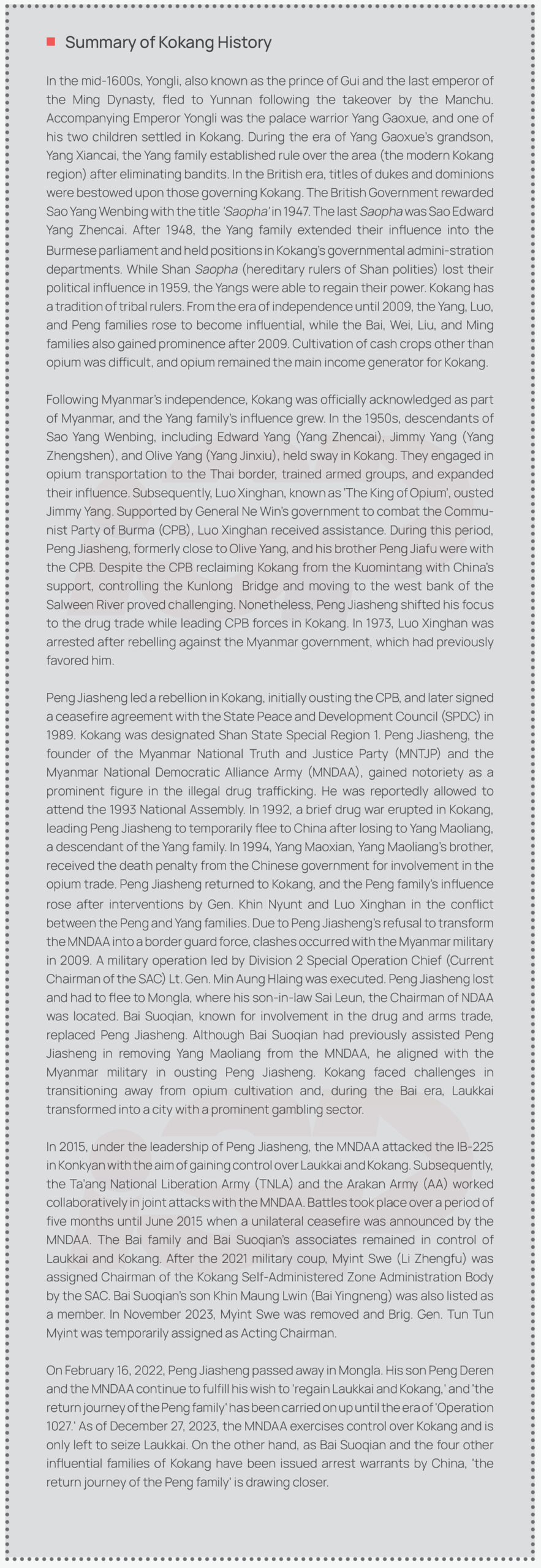

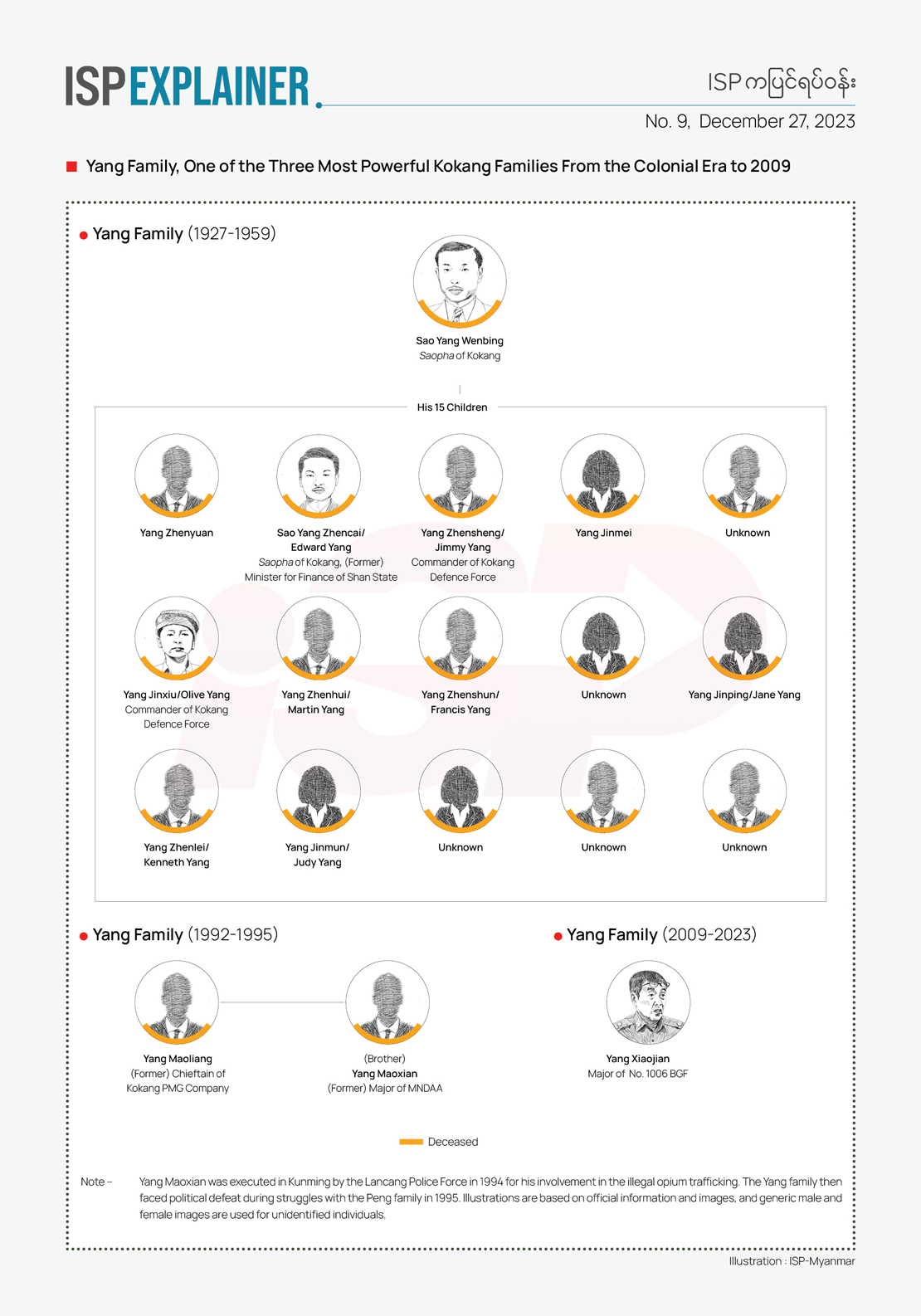
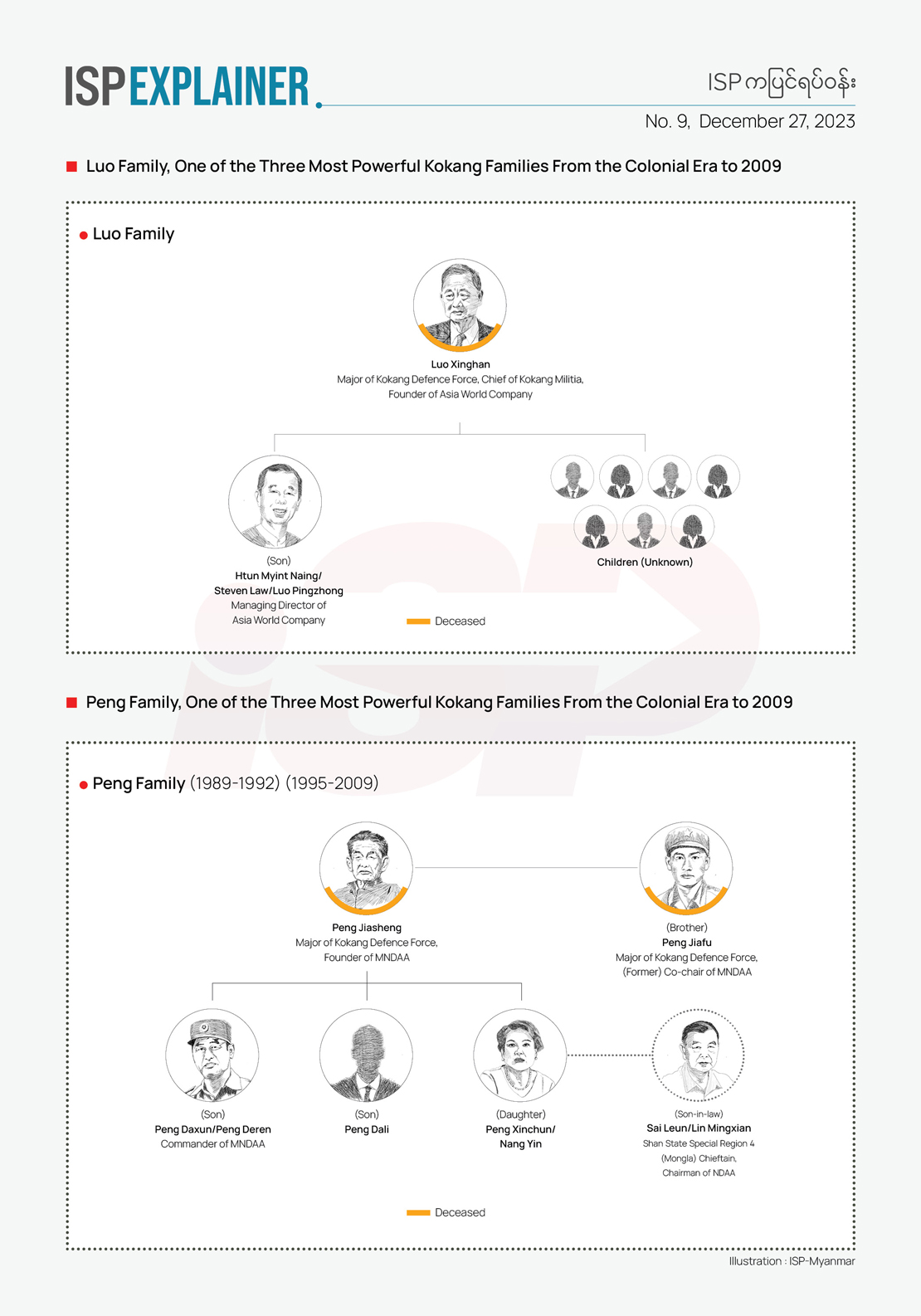
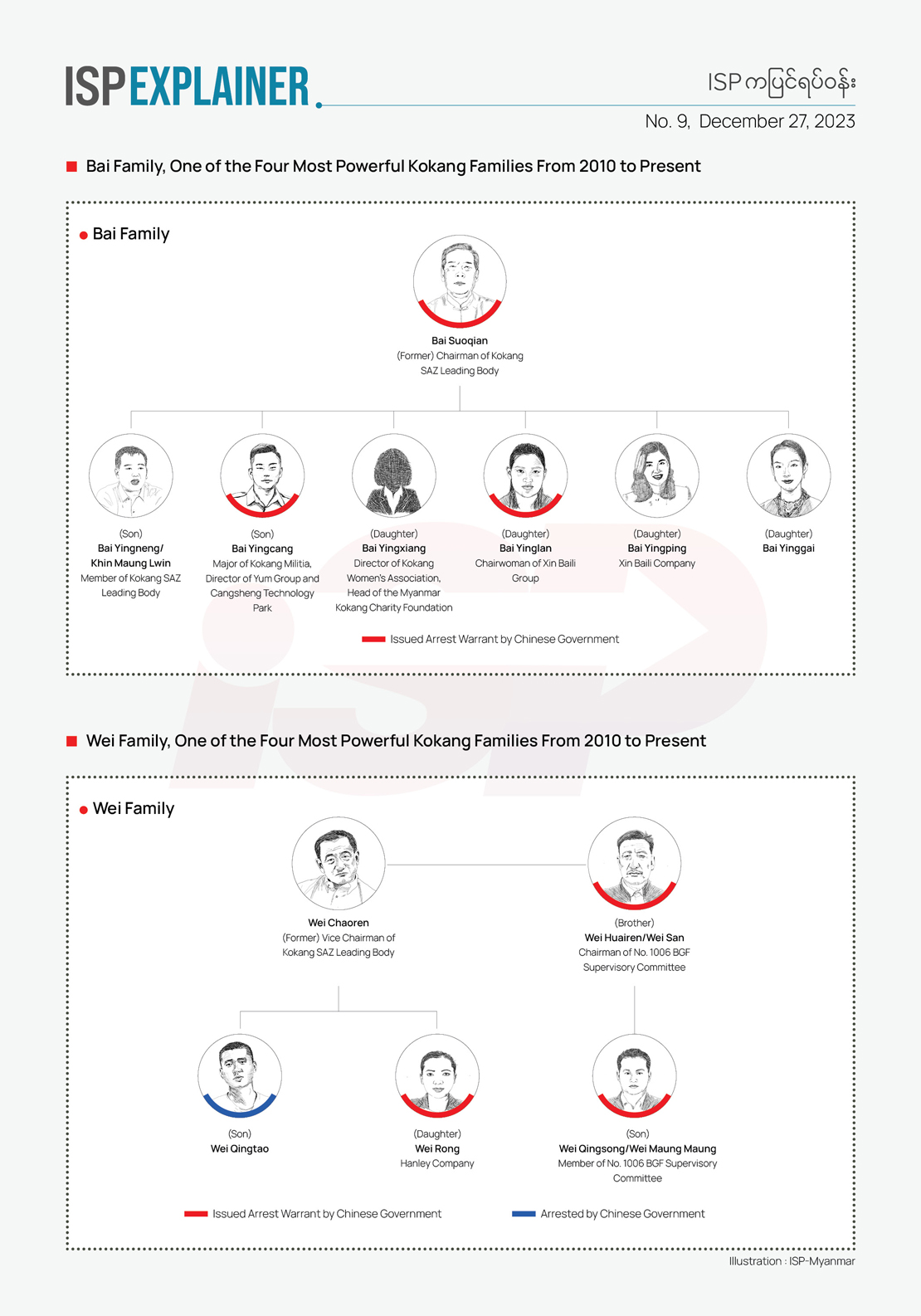
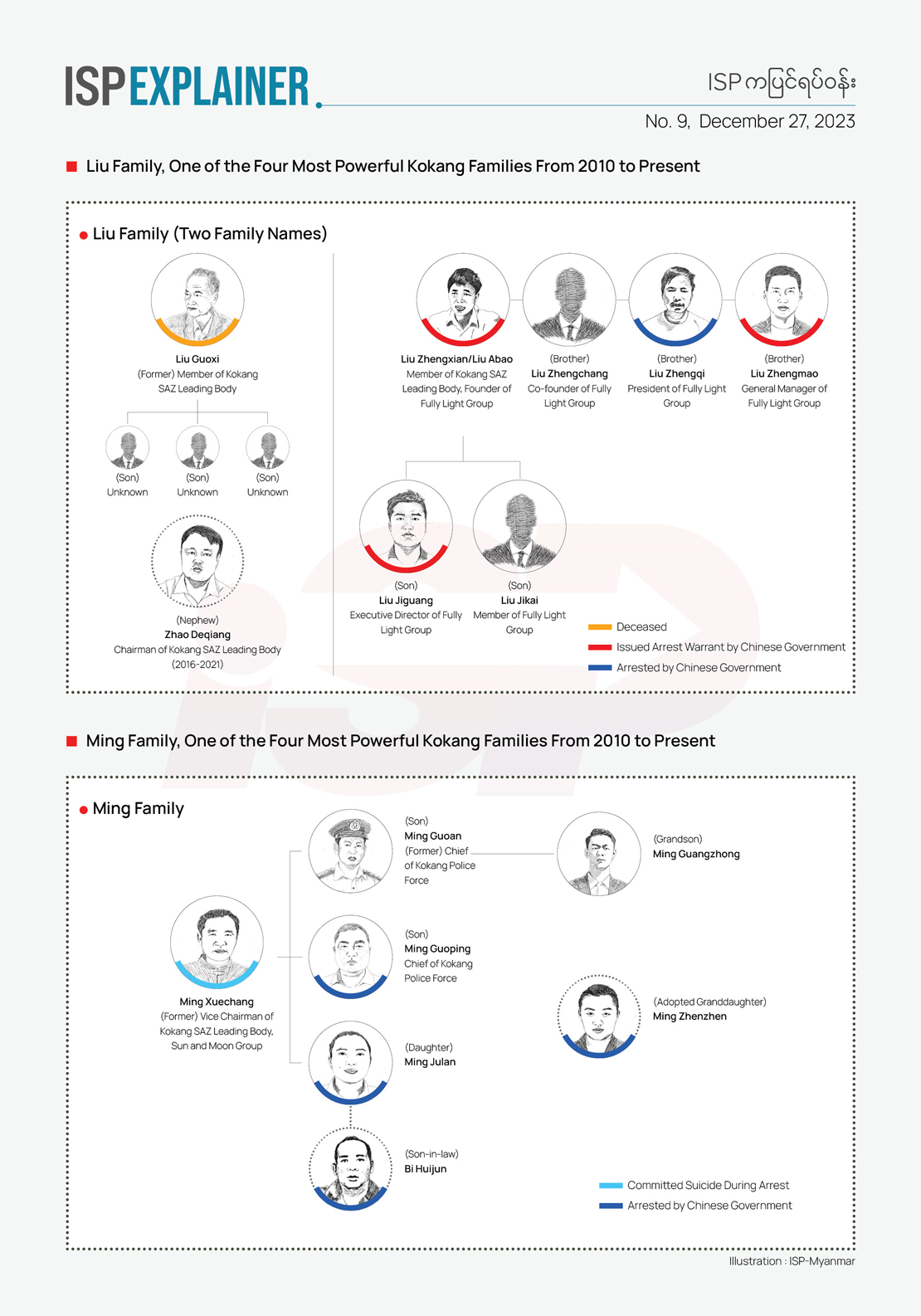
2.‘Operation 1027’ and China’s Growing Influence
After 45 days since the launch of ‘Operation 1027’ by the 3BHA, China has begun to exert its influence. Representatives from the SAC and the 3BHA met at the Kunming Haigeng Hotel from December 7 to 9. During the meeting, Special Envoy for Asian Affairs of China Ministry of Foreign Affairs Mr. Deng Xijun, attended as a witness on behalf of the Beijing. The meeting, reported on December 11 by China and the SAC, primarily discussed a temporary ceasefire, prisoner of war exchanges, and war refugee assistance. According to China, discussions achieved a ‘good result’ that would benefit the interests of all parties. The SAC announced plans for another meeting by the end of December, meaning the SAC reaction to the situation with the 3BHA was now being overseen by China in its pledge to assist Myanmar in resolving its political issues. The two sides did meet again for a second time from December 22 to 24 in Kunming, China, but no significant agreements were made.
After the first meeting in Kunming, clashes between the MNDAA and the SAC reduced in number. However, SAC clashes with the TNLA and AA, especially with the TNLA and its joint forces, which saw an increase. Since December 11, the TNLA and joint forces were able to seize Namkham, Namhsan, and Manton as well as three townships. The MNDAA was also able to capture Yanlonkyaing (Yan Long Zhai) border gate in Laukkai on December 18 and some battles with the SAC forces also occurred around Laukkai. Due to this incident, on December 20, the China’s Ministry of Foreign Affairs requested all armed groups to halt operations.
Details of any agreements reached during the Kunming meeting were not officially announced by the SAC nor the 3BHA. However, on December 12, a draft of the Ridge Consensus in Chinese and English widely circulated on social media. There is no evidence where the draft originated, but it has been assumed that the 3BHA, leveraging its media power, including strong social media presence, chose not to release it. Although both sides have not formally announced any agreements, the draft released on social media included a seven point plan as the ‘Agreement for Ending Conflict in Northern Myanmar.’ These points included:
– A ceasefire and the end of war operations before December 2023
– The release of war and related prisoners
– Ensuring the safety of civilians
– Aiding war refugees
– Refraining from attacking civilian locations
– With the help of China, eliminating online crime in areas under military control, and arresting and
transferring Kyar Phyant gang members and associates to the Chinese government
– Embracing peace, and not being disruptors of peace.
Moreover, the leaked document showed agreements for MNDAA being allowed to return to Laukkai, parties engaging in political dialogue to find solutions, the 3BHA not attacking Laukkai in strength, and the 3BHA cooperating with the SAC military in regulating and strengthening the flow of trade at cross-border gates.
After the second meeting in Kunming, no clear response from either the 3BHA or the SAC was released. There were also no immediate reports on the results of bilateral discussions between both China and the SAC. However, according to media reports, the ‘Haigeng Agreement’ from the first meeting to cease fire until the end of December was further discussed. Relocation of forces from both sides and reopening China-Myanmar border trade were also discussed, but no agreements were made. Media reports also suggest that a third meeting will take place in January 2024. In a BBC (Burmese) video interview released on December 26, TNLA Gen. Sec. Gen. Tar Bone Kyaw stated, “As the battles intensify, China is pressuring us to stop the fight. All three of our forces are trying to find an answer to overcome this issue.”
ISP-Myanmar has analyzed the major outcomes since the launch of ‘Operation 1027’ in three OnPoint publications. OnPoint 17, released on November 10, highlighted the signaling effects of ‘Operation 1027.’ China’s power reconfiguration in northern Shan state was also analyzed across three key factors. ‘Operation 1027’ may be implicitly permitted by China, however Myanmar’s conflict actors are not just passive actors but demonstrated their own agency and they can reinvent their positions within the given situation to maximize their strategic options.
OnPoint 18 from November 12 also highlighted that China is willing to accept ‘Operation 1027,’ which implies that a short-term conflict in the northern Shan State and Salween River basin lasting up to three months might be tolerated, considering the broader political, security, and economic factors mentioned above. However, if the conflict were to escalate and extend to Naypyitaw, and if the National Unity Government (NUG) and its People Defense Forces (PDF), groups that China is suspicious of due to their links with Western countries, were to play a significant role, it could potentially disrupt the power balance in Myanmar and even lead to the replacement of the current junta. In such a scenario, China might be hesitant to accept the consequences. Furthermore, if the conflict persists, the probability of other powers, such as Russia or the United States, getting involved increases. In this situation, China would have a vested interest in ending the conflict as soon as possible. The unforeseen risks associated with being closely tied to the border conflict area would undoubtedly be assessed by China. The unexpected twists and turns of various dynamics make it difficult to achieve a straightforward outcome in any conflict.
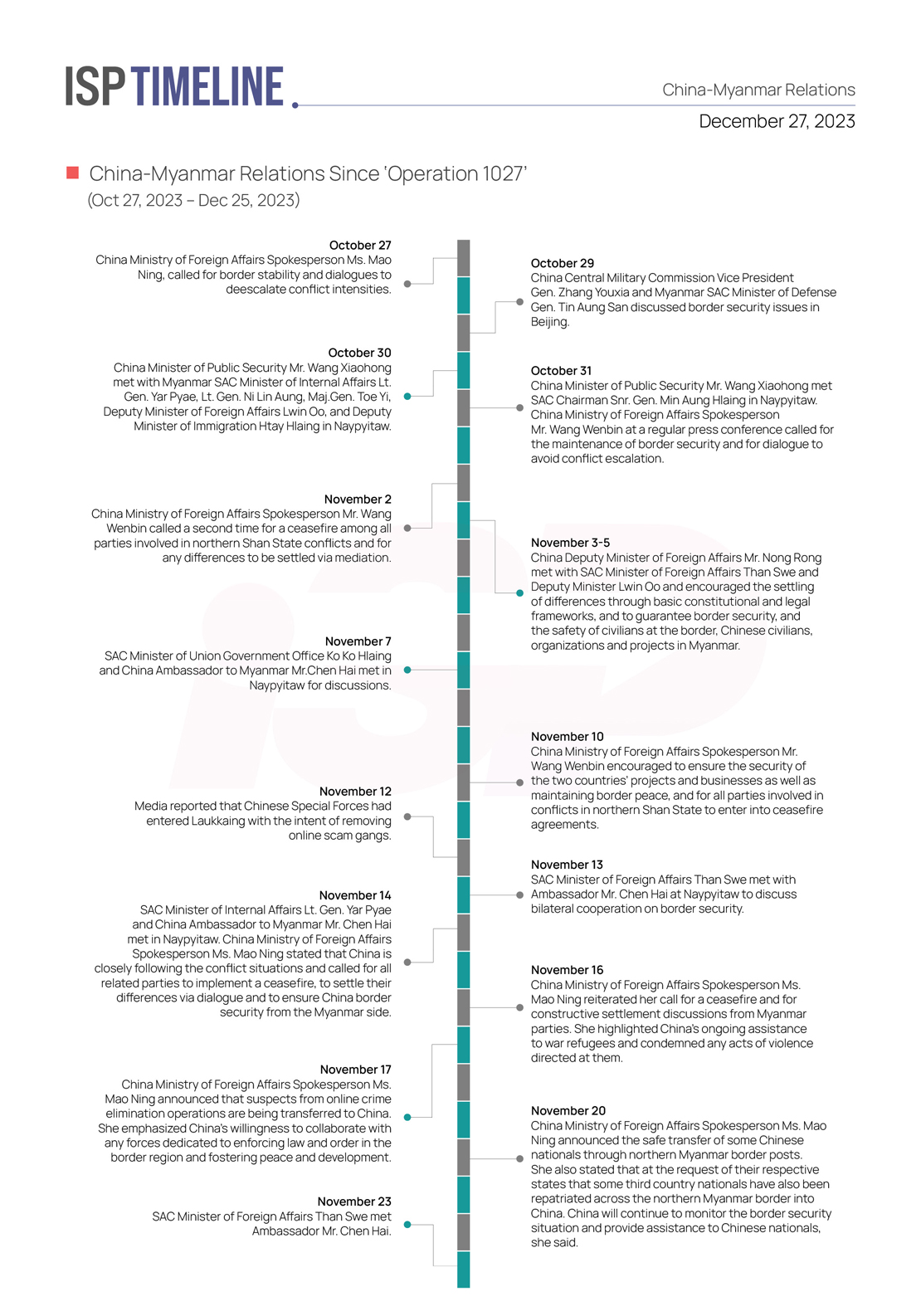

ISP OnPoint 19, published on December 5, additionally highlighted that if ‘Operation 1027,’ conducted by the 3BHA forces, is successful in occupying a satisfactory number of territories, expanding their sphere of influence, and controlling economically significant areas and transport routes, then the operation’s momentum could rapidly slow or even come to a halt. If the United Wa State Army (UWSA) and Kachin Independence Army (KIA) were to actively collaborate with the 3BHA operation, unless they pursued their own military or political objectives, the combined resistance could lead to an all-out (a total) civil war. Therefore, it is crucial to closely monitor how larger armed groups, such as the UWSA and KIA, decide to act, as it demonstrates one of the most important ‘signaling effects’ of the armed resistance. If the 3BHA and other major Ethnic Armed Organisations engage in the conflict with limited objectives, even if restrained or entered a truce due to various reasons, including pressure from China, they can still support the People’s Defense Forces (PDF) and Local Defense Forces (LDF) under their sphere of influence. This support could strengthen a strategy to wear down and weaken the junta military. Finally, in the event that ‘Operation 1027’ does not lead to an all-out (a total) civil war, the outcomes of the operation could lead to a ‘protracted war.’
ISP-Myanmar has often highlighted how China handles Myanmar with a frontier management strategy. As ‘Operation 1027’ intensifies, China’s Southern Theater Command engaged in a three-day military exercise on November 25 along the China-Myanmar border. China clarified that these maneuvers are aimed at safeguarding sovereignty, border security, the security of Chinese nationals, and emergency defense, explicitly disavowing any intent to interfere in Myanmar’s internal affairs. This seems to be a response to the possibility of spillover effects into Chinese territory from Myanmar’s ‘Operation 1027.’ Concurrently, three naval ships along with 700 Chinese soldiers led by Senior Captain Sun Bo arrived at Thilawa Port Terminal on November 27. The 44th PLA Navy Escort Task Group (ETG) that has been on a goodwill visit arrived three weeks after Russia-Myanmar marine exercises. China appears to be sending a message that it is unwilling to permit interference in Myanmar’s internal conflict by other major powers. Simultaneously, there is a clear prioritization of political stability, with Beijing assuming the role of a conflict mediator, to ensure the safety of Chinese nationals and Chinese interests. China seems keen to avoid a scenario akin to the Libya civil war, where tens of thousands of Chinese nationals had to be evacuated due to regime change—a situation China aims to avoid in Myanmar.
3.Regaining Momentum on the Kyaukphyu Special Economic Zone (SEZ)
The SAC has concentrated its efforts to implement the Kyaukphyu SEZ (one of the strategic projects under CMEC), which will secure an Indian Ocean gateway for China. Since the launch of ‘Operation 1027,’ the 3BHA has captured territory in northern Shan State where six China projects are located as well as gaining partial control over other project sites (see ISP OnPoint No. 18). Throughout ‘Operation 1027,’ battles have been fought in northern Rakhine area, in particular around the India-invested Kaladan Multi-Modal Transit Transport Project. While there has yet to be significant impact from the action, the potential impact also expands to the Kyaukphyu SEZ and a 15-mile radius surrounding it, potentially affecting Chinese investments in the region.
Nonetheless, the SAC is attempting to begin implementation of the Kyaukphyu project in early 2024. Ms. Cao Jing, Minister Counselor of the Chinese Embassy in Myanmar, and Mr. Xi Guohua, China International Trust Investment Cooperation (CITIC) Group’s Chairman, met with Aung Naing Oo, Union Minister of Commerce, and Chiarman of Myanmar Special Economic Zone Central Working Body to discuss contract preparations for the Kyaukphyu SEZ. An Addendum to the contract was signed under the leadership of General Mya Tun Oo on December 26. As the SAC ordered to start the implementation of the project as soon as possible, the Rakhine State Administration Council and SEZ Management Committee met on November 3 to prepare the project site. Deliberations included decisions on land acquisition and compensation plans for affected areas. Concurrently, SAC plans are underway to establish a Myanmar Government Designated Entity (GDE) Consortium, with the Ministry of Commerce’s Myanmar Trade Promotion Organization issuing a call for expressions of interest from November 6 to December 15.
China and Myanmar have also signed three Memoranda of Understanding (MoU) and a contract agreement as a part of the Bangladesh, China, India and Myanmar Economic Corridor (BCIM). The three MoUs concern the Kanpaikti-Myitkyina-Pansaung highway project, the Tengchong-Myitkyina-Pansaung Logistic Service project, and the Kanpaikti Cross-border Economic Cooperation Zone. An additional contract was signed on October 22 in Yunnan Tengchong, concerning aid funding for highway and bridge construction. In addition, on November 7 the SAC signed an agreement with Power China Resources Limited to purchase energy generated from solar power plant factory projects in Kyee Ohn Kyee Wa, KinTar and Sidoktaya. A combined 90 megawatts produced by these three projects will be distributed to Magway and Mandalay regions. While the Kunlong Bridge has been completed and an opening ceremony was set to take place on November 11, due to the ongoing conflict in northern Shan State, the ceremony has yet to take place. The new Kunlong Bridge crosses the Salween river and was one of the earliest CMEC projects and the first project to be completed. The new bridge along the Hseni-Chinshwehaw road as well as the old suspension bridge beside it were seized by the MNDAA and joint forces on November 12.
4.Lancang-Mekong Cooperation Summit Attended by the SAC Chairman
The Lancang-Mekong Cooperation (LMC), which had been on hiatus for over three years, resumed online on December 25, with SAC Chairman Snr. Gen. Min Aung Hlaing in attendance. Myanmar and China had co-chaired the Lancang-Mekong Cooperation meetings from August 2020 to December 2023. During the period of operation, summits were supposed to be held every two years, along with other related meetings. The 2021 coup in Myanmar resulted in legitimacy issues for the military leadership in international fora, leading to invitations being revoked for the SAC Chairman for ASEAN summits and other regional summits. While China had initially paused the LMC summit, they later resumed it and allowed the SAC Chairman to attend. Therefore, this latest fourth LMC summit became the first regional meeting that the SAC Chairman was able to attend.
China Premier Mr. Li Qiang co-hosted the meeting with the SAC Chairman while ministers from Cambodia, Lao, Thailand, and Vietnam attended. At the summit, LMC developments were analyzed, and both the Naypyitaw Declaration and the Lancang-Mekong Cooperation Five-Year Plan of Action (2023-2027) were confirmed. In documents from China, the SAC Chairman was referred to as the ‘Myanmar Leader’ rather than as ‘Prime Minister’ (self-identified title) as other country leaders in attendance were. It is significant that in the reconstituted online summit China has persisted with Myanmar as Co-chair given that Myanmar’s three-year term as Co-chair is set to expire soon as well as the meeting occurred after China intervened to contain the expansion of conflict between the SAC and the 3BHA.
Following China’s grand reopening after Covid-19, most LMC meetings have taken place in person. The 8th LMC Foreign Ministers meeting was attended by SAC Foreign Affairs Minister Than Swe on December 7 in Beijing. The 10th High Officials meeting was held from November 3 to 5 in Naypyitaw, with Assistant Minister of Foreign Affairs Mr. Nong Rong in attendance. Mr. Nong Rong announced that the Lancang-Mekong Economic Development Belt proposed by Mr. Wang Yi from the previous meeting would receive more funding.
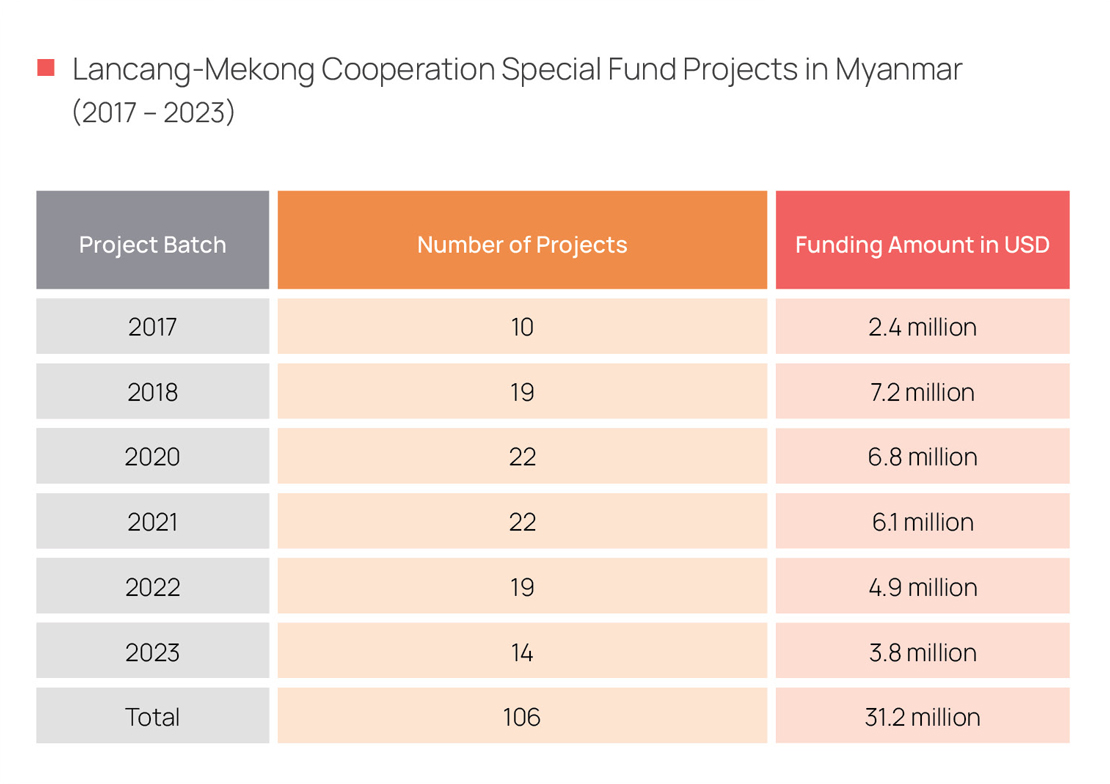
With LMC special fund from 2022, the Mekong-Lancang Project’s Crop Yield Assessment Center Opening took place on November 7 in Naypyitaw. The Agricultural Management and Statistics Department stated that cultivation techniques employing drones will be used. The Lancang-Mekong cooperation, a regional integration effort spearheaded by China to extend its influence in the Mekong region, encompasses numerous projects. As of 2023, among the 779 LMC special funding projects across member countries, Myanmar hosts over 106 projects valued at USD 31.2 million. LMC projects are implemented in Myanmar by the Ministries of Agriculture, Livestock and Irrigation, Science and Technology, Cooperatives and Rural Development, Religious Affairs and Culture, Natural Resources and Environmental Conservation, and Home Affairs. Addition-ally, President Xi Jinping’s Global Security Initiative (GSI), Global Development Initiative (GDI) and Global Civilization Initiative (GCI) are also to be implemented through the LMC.
5.Launch of the Cross-Border Interbank Payment System (CIPS)
China’s Cross-Border Interbank Payment System (CIPS) is now operational in Myanmar. At Industrial and Commercial Bank of China (ICBC) Yangon Branch, yuan payments can now be made on bilateral trade and investments. Myanmar financial institutions will now be able to connect to global CIPS clearing and settlement networks from inside Myanmar. ICBC Yangon Branch connected to the CIPS system on October 18 and interbank cross-border yuan payments started on October 23. The China-Myanmar bilateral yuan payment trade system began in 2021. In order to bypass the SWIFT system sanctioned by Western countries, the SAC will use China’s CIPS to connect with international banking institutions. Later, domestic Myanmar banks could use the Central Bank of Myanmar Financial Network System (CBM NET) to connect with CIPS, becoming an indirect participant.
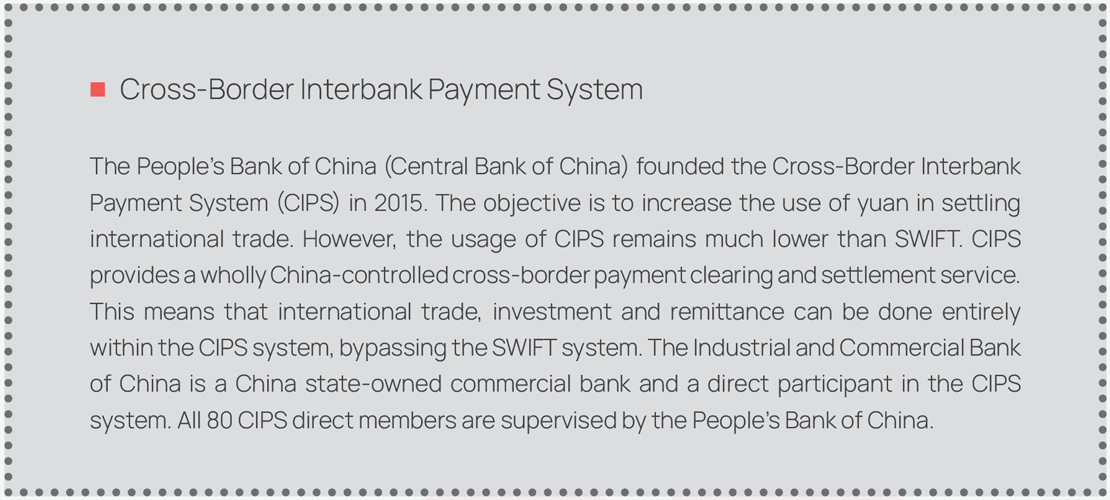
In terms of physical trade though, China-Myanmar border trade has taken a hit. Since fighting began in northern Shan State, border trade with China has effectively halted. Trade through the Muse and Chinshwehaw border gates, which together ordinarily accounts for 91 percent of total border trade between China and Myanmar, is now losing an average of USD 9 million per day (see ISP OnPoint No. 18). Trade ordinarily also takes place through eastern Shan State Special Region 4’s Mongla and China’s Daluo border gates. On November 12, Shan State Special Region 4 Tax Department announced a 50% reduction in trade tax starting from November 13, 2023. And the SAC Department of Commerce announced on November 8 that trade with China will also become available through other border gates as well as the trade via maritime.
References:
China Daily. (2023, November 25). PLA to hold live-fire drills on China-Myanmar border. China Military. http://eng.chinamil.com.cn/CHINA_209163/TopStories_209189/16269120.html
Global Times. (2023, November 1). China hopes for stability in Myanmar the most, this remains unwavering: Global Times editorial. https://www.globaltimes.cn/page/202311/1301040.shtml
Mao Ning. (2023, December 14). Foreign Ministry Spokesperson Mao Ning’s Regular Press Conference on December 14, 2023. Ministry of Foreign Affairs of the People’s Republic of China. https://www.fmprc.gov.cn/eng/xwfw_665399/s2510_665401/2511_665403/202312/t20231214_11202549.html
Ministry of Commerce. (2023, November 6). ကျောက်ဖြူအထူးစီးပွားရေးဇုန်ဆိုင်ရာ အစိုးရအသိအမှတ်ပြု မြန်မာနိုင်ငံသားပိုင်ကုမ္ပဏီများပါဝင်သည့် အဖွဲ့အစည်း(Myanmmar GDE Consortium) ဖွဲ့စည်းရေးအတွက် စိတ်ဝင်စားမှုအဆိုပြုလွှာ(Expression of Interest-EOI)ခေါ်ယူခြင်း. https://bit.ly/47QPwtj
Ministry of Foreign Affairs of the People’s Republic of China. (2023, December 7). The Eighth LMC Foreign Ministers’ Meeting Held in Beijing. http://ae.china-embassy.gov.cn/eng/zgyw/202312/t20231211_11199386.htm
Myanmar National Post. (2023, November 4). (၁၀) ကြိမ်မြောက် မဲခေါင်-လန်ချန်းပူးပေါင်းဆောင်ရွက်မှု အဆင့်မြင့်အရာရှိကြီးများအစည်းအဝေးကို နေပြည်တော်၌ လက်ခံကျင်းပ. Myanmar National Post. https://www.mmnationalpost.com/2023/11/blog-post_32.html
စီးပွားရေးနှင့် ကူးသန်းရောင်းဝယ်ရေးဝန်ကြီးဌာန. (၂၀၂၃၊ ဒီဇင်ဘာ ၁၂). မြန်မာအထူးစီးပွားရေးဇုန်ဆိုင်ရာဗဟိုလုပ်ငန်းအဖွဲ့၏ (၄/၂၀၂၃) ကြိမ်မြောက် လုပ်ငန်းညှိနှိုင်းအစည်းအဝေးသို့ မြန်မာ အထူးစီးပွားရေးဇုန်ဆိုင်ရာဗဟိုလုပ်ငန်းအဖွဲ့ ဥက္ကဋ္ဌ၊ ပြည်ထောင်စု အစိုးရအဖွဲ့ရုံးဝန်ကြီးဌာန(၁)၊ ပြည်ထောင်စုဝန်ကြီး တက်ရောက် အမှာစကားပြောကြား. Ministry of Commerce. https://bit.ly/3NVYfTx
中国日报网. (2023, October 24). 孟中印缅地区国际物流通道合作论坛在云南腾冲开幕. https://bit.ly/3ts9LPh
央视新闻客户端. (2023, December 10). 公安机关悬赏通缉白所成、魏怀仁等10名缅北果敢电诈头目. https://bit.ly/3v3OR9z
PLA to hold live-fire drills on China-Myanmar border – China Military
A spokesperson with the People’s Liberation Army announced on Saturday that live-fire drills will be conducted in the Chinese side of the China-Myanmar border.

